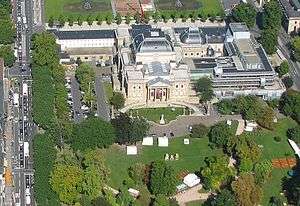Hessisches Staatstheater Wiesbaden
| Hessisches Staatstheater Wiesbaden | |
|---|---|
 Aerial view of the theatre in Wiesbaden, the capital of Hesse | |
| General information | |
| Location | Wiesbaden, Hesse, Germany |
| Coordinates | 50°05′01″N 8°14′45″E / 50.08361°N 8.24583°ECoordinates: 50°05′01″N 8°14′45″E / 50.08361°N 8.24583°E |
| Construction started | 1892 |
| Completed | 1894 |
| Design and construction | |
| Architect | |
| Website | |
|
www | |
The Hessisches Staatstheater Wiesbaden is the State Theatre of the German state Hesse in the capital Wiesbaden, producing operas, plays, ballets, musicals and concerts on four stages. It is also known as Staatstheater Wiesbaden or Theater Wiesbaden, its orchestra as the Hessisches Staatsorchester. The building was inaugurated in 1894.
The theatre is the host for the annual festival Internationale Maifestspiele Wiesbaden, established in 1896 after the Bayreuth Festival.
History

The building of the theatre was initiated and substantially supported by the German emperor William I who regularly visited the spa in Wiesbaden. A competition was won by a team of architects from Vienna, Ferdinand Fellner and Hermann Helmer. They erected the building from 1892 to 1894 in Baroque Revival style, following models in Prague and Zurich.[1] The inauguration was on 16 October 1894 in the presence of the emperor. The Foyer was built in 1902 by architect Felix Genzmer.[2] It serves three stages.
After World War I the theatre was renamed "Preußisches Staatstheater" (Prussian State Theatre). Since 1932 the city of Wiesbaden was responsible for the theatre, therefore it was renamed "Nassauisches Landestheater" (Theater of the Province Nassau).
The building was seriously damaged in World War II by a bomb on 3 February 1945. The front was restored in a simplified way and the ceiling of the hall was decorated with a contemporary painting.
In 1946 the State of Hesse took over the operation of the theatre. In 1947 it was used again and called "Großhessisches Staatstheater" (State Theater of Great Hesse), later "Hessisches Staatstheater Wiesbaden".
From 1975 to 1978 the auditorium was restored according to the historic model. The technical equipment was modernized.[3] A new tract was built, designed by Hardt-Waltherr Hämer, for rehearsal rooms, workshops and administration.
Performance facilities
The theatre has four stages, three of them in the historic house:
- Großes Haus (Great House) with 1,041 seats.
- Kleines Haus (Small House) with 328 seats.
- Studio with 89 seats.
- Wartburg, from 2003, is an additional small separate stage.
The staff consist of about 600 people.[4] Annually more than 25 new operas, plays and ballets have been produced.[3][5]
The theatre is especially dedicated to a young audience, collaborating with schools for "Schultheatertage". A professional ensemble, "Junges Staatstheater" (Young State Theater) is dedicated to children's and youth theater.[3]
In addition to the annual Internationale Maifestspiele in May, since 2004 a biennial festival "Neue Stücke aus Europa" (New European Plays) is organized in collaboration with the Staatstheater Mainz, presenting in ten days new plays in the original language with simultaneous translation.[6]
Directors
|
|
|
Orchestras and conductors
Städtisches Cur- und Sinfonieorchester
Wiesbaden's first major orchestra was in 1873 the "Städtisches Cur- und Sinfonieorchester" (Communal Spa and Symphony Orchestra). Its conductor from 1874 to 1905, Louis Lüstner, established besides entertaining music for the spa audience twelve symphony concerts a year. During this period Johannes Brahms, Clara Schumann, Joseph Joachim, Camille Saint-Saëns and Pablo de Sarasate appeared in concert, among others. Felix Mottl was a regular guest conductor from 1894. The number of players was raised from 56 to 65 in 1905 to 1911. From 1912 Carl Schuricht was the conductor, appointed Generalmusikdirektor (GMD) 1921. Regular guest conductors during his era, which lasted until 1944, included Fritz Busch, Felix Weingartner, Bruno Walter and Richard Strauss.[3]
Staatskapelle
The second orchestra "Staatskapelle", was founded in 1894, with the new opera house, to play exclusively opera and ballet. Conductors included:
|
|
Guest conductors included Thomas Beecham, Leo Blech and Fritz Busch. Richard Strauss conducted opera almost annually.[3]
Hessisches Staatsorchester
After the war, a fusion of the two orchestras under the new name Hessisches Staatsorchester was initiated and finalized by Wolfgang Sawallisch end of the 1950s. Conductors included:
|
|
|
References
Notes
- ↑ "Hessisches Staatstheater". structurae.info. 2006.
- ↑ "Hessisches Staatstheater Wiesbaden". bauwerk-weimar.de. 2004.
- 1 2 3 4 5 6 7 8 9 10 11 12 13 14 15 16 Achim Thorwald. "Hessisches Staatstheater Wiesbaden" (in German). European Business Network. Retrieved 27 April 2011.
- ↑ "Hessisches Staatstheater" (in German). archinform.net. 2011.
- ↑ "Hessisches Staatstheater Wiesbaden" (in German). Kultur in Deutschland Online. 2011.
- ↑ "Hessian State Theatre". Wiesbaden. 2011.
- 1 2 Sadie, Stanley (ed) (1992). The New Grove Dictionary of Opera, vol. 4, pp. 1154–5, "Wiesbaden", by Gábor Halász. Oxford: Oxford University Press. ISBN 978-0-19-522186-2.
Other sources
- Rudolf Cyperrek, Otto Laux, Hans-Peter Scholz: Geschichte eines Theatergebäudes 1860–1978. Hessisches Staatstheater, Wiesbaden 1978. (German)
- Peter Schabe: Hessisches Staatstheater Wiesbaden. Verlag Schnell & Steiner, München 1988 (Kunstführer; Bd. 1712). (German)
- Das neue kgl. Theater in Wiesbaden. In: Zeitschrift des österreichischen Ingenieur- und Architekten-Vereins. Jg. 51 (1899), Nr. 1, urn:nbn:de:kobv:co1-opus-18787, S. 1–4. (German)
External links
| Wikimedia Commons has media related to Hessisches Staatstheater Wiesbaden. |
- Hessisches Staatstheater Wiesbaden Official website
- Jugendclubtheater website (German)